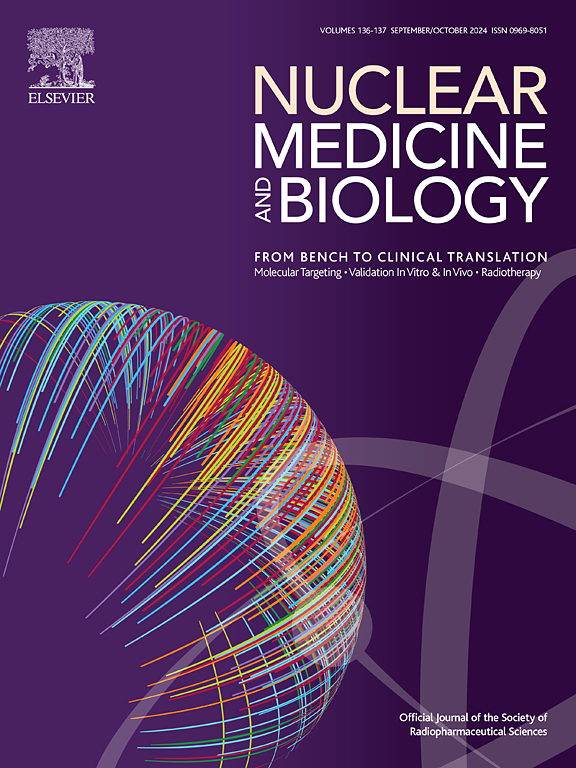Affinity maturation and optimization of CD44v6-targeting antibodies for molecular radiotherapy
IF 3.6
4区 医学
Q1 RADIOLOGY, NUCLEAR MEDICINE & MEDICAL IMAGING
引用次数: 0
Abstract
Aim
This study aimed to improve the efficacy of the CD44v6-targeting antibody UU-40 for molecular radiotherapy through affinity maturation and IgG subclass optimization.
M&M
A panel of affinity-matured antibody candidates was generated and characterized as both human IgG4 and IgG1 with LALA mutations. Surface plasmon resonance and LigandTracer analyses identified several candidates with superior affinity and off-rates compared to the parental UU-40. Biodistribution studies in xenograft models using Lutetium-177 (177Lu)-labeled antibodies showed improved tumor retention for selected candidates, particularly UU-A-155. Species cross-reactivity assays confirmed binding to cynomolgus and rabbit v6-peptides, supporting future toxicity studies.
Results
The IgG1 LALA format demonstrated reduced binding to Fcγ receptors, potentially improving the safety profile. UU-A-155 emerged as the lead candidate for clinical translation, showing superior performance in both affinity and tumor retention. Our findings highlight the importance of comprehensive in vitro and in vivo assessments in antibody development, and provides valuable insights into optimizing antibody-based molecular radiotherapy.

靶向cd44v6分子放疗抗体的亲和成熟与优化
目的通过亲和成熟和IgG亚类优化,提高靶向cd44v6的抗体UU-40在分子放疗中的疗效,生成亲和成熟候选抗体m&;MA,鉴定为LALA突变的人IgG4和IgG1。表面等离子体共振和配体示踪分析确定了几个候选物,与亲本UU-40相比,它们具有更高的亲和力和脱靶率。使用Lutetium-177 (177Lu)标记的抗体在异种移植模型中的生物分布研究显示,选定的候选物,特别是UU-A-155,可以改善肿瘤保留。物种交叉反应试验证实与食蟹和兔的v6-肽结合,支持未来的毒性研究。结果IgG1 LALA格式显示与Fcγ受体的结合减少,可能提高安全性。UU-A-155作为临床翻译的主要候选,在亲和力和肿瘤保留方面表现优异。我们的研究结果强调了在抗体开发中全面的体外和体内评估的重要性,并为优化基于抗体的分子放疗提供了有价值的见解。
本文章由计算机程序翻译,如有差异,请以英文原文为准。
求助全文
约1分钟内获得全文
求助全文
来源期刊

Nuclear medicine and biology
医学-核医学
CiteScore
6.00
自引率
9.70%
发文量
479
审稿时长
51 days
期刊介绍:
Nuclear Medicine and Biology publishes original research addressing all aspects of radiopharmaceutical science: synthesis, in vitro and ex vivo studies, in vivo biodistribution by dissection or imaging, radiopharmacology, radiopharmacy, and translational clinical studies of new targeted radiotracers. The importance of the target to an unmet clinical need should be the first consideration. If the synthesis of a new radiopharmaceutical is submitted without in vitro or in vivo data, then the uniqueness of the chemistry must be emphasized.
These multidisciplinary studies should validate the mechanism of localization whether the probe is based on binding to a receptor, enzyme, tumor antigen, or another well-defined target. The studies should be aimed at evaluating how the chemical and radiopharmaceutical properties affect pharmacokinetics, pharmacodynamics, or therapeutic efficacy. Ideally, the study would address the sensitivity of the probe to changes in disease or treatment, although studies validating mechanism alone are acceptable. Radiopharmacy practice, addressing the issues of preparation, automation, quality control, dispensing, and regulations applicable to qualification and administration of radiopharmaceuticals to humans, is an important aspect of the developmental process, but only if the study has a significant impact on the field.
Contributions on the subject of therapeutic radiopharmaceuticals also are appropriate provided that the specificity of labeled compound localization and therapeutic effect have been addressed.
 求助内容:
求助内容: 应助结果提醒方式:
应助结果提醒方式:


